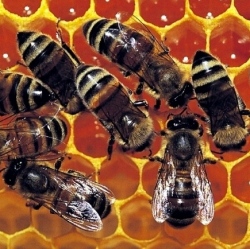
Millions of people depend on the struggling honeybeeon in order to pollinate crops and other plants. These valuable pollinators have faced widespread problems including colony losses over the past decade, largely due to the spread of a predatory mite called Varroa destructor.
But the bees might not be in as dire a state as it seems, according to research recently published in Nature Communications. Researchers found a population of wild bees from around Ithaca, New York, which is as strong today as ever, despite the mites invading the region in the mid-1990s.
"They took a hit, but they recovered," said Alexander Mikheyev, a professor at the Okinawa Institute of Science and Technology Graduate University (OIST) in Japan and lead paper author. "The population appears to have developed genetic resistance."
Mikheyev and his collaborators at OIST and Cornell University studied the population genetics of the wild colony by comparing the DNA of specimens collected in 1977 with bees collected from the same forest in 2010. To conduct the study, they developed a new DNA analysis tool that works especially well for degraded DNA stored in museum samples.
Such a study is extremely rare, especially with bees. Few people collect them, and even fewer collect in a way that is good enough for a population level study. Luckily, Cornell Professor Tom Seeley worked in this area during his Ph.D., and deposited his samples in the Cornell University Insect Collection. This is the first time scientists have been able to observe genome-wide changes after a specific event like the mite invasion. "By using museum specimens, we see how evolution happens as compared to how we think it happens," said Mikheyev, who runs OIST’s Ecology and Evolution Unit.
Many people think of evolution happening over thousands or millions of years, but in fact, it is happening from generation to generation. External forces cause certain traits to be selected and passed on to offspring to enhance their chance of survival and reproduction. By comparing bees from the same colony only a few decades a part, the team was able to see this natural selection in action.
